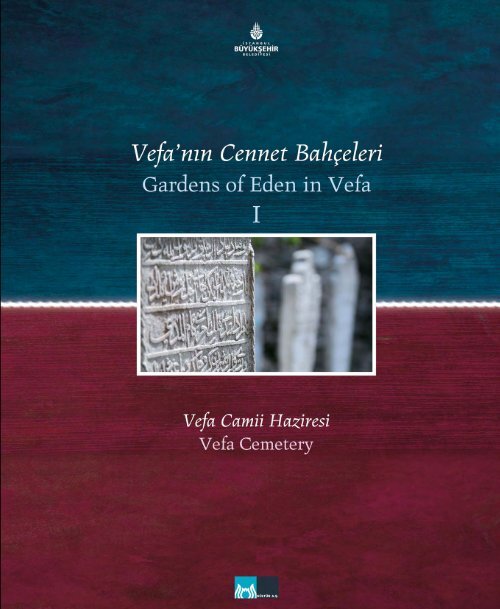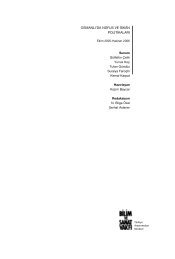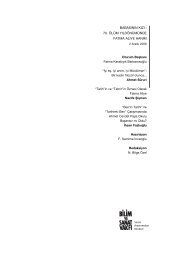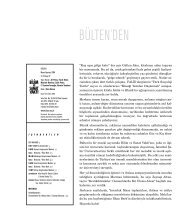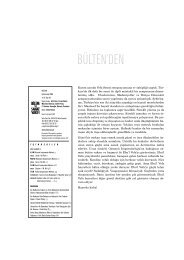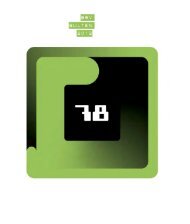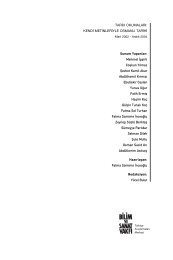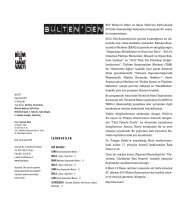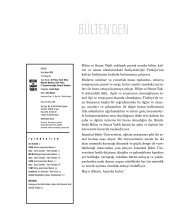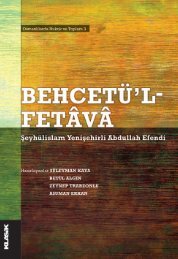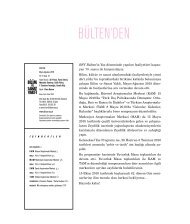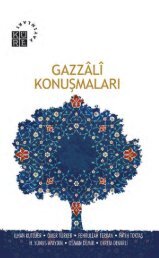kitap 6 (pdf) indir - Bilim ve Sanat Vakfı
kitap 6 (pdf) indir - Bilim ve Sanat Vakfı
kitap 6 (pdf) indir - Bilim ve Sanat Vakfı
You also want an ePaper? Increase the reach of your titles
YUMPU automatically turns print PDFs into web optimized ePapers that Google loves.
‹STANBUL BÜYÜKfiEH‹R BELED‹YES‹ KÜLTÜR A.fi. YAYINLARI<br />
‹STANBUL METROPOLITAN MUNICIPALITY CULTURE CO. PUBLICATIONS<br />
Maltepe Mah. Topkap› Kültür Park› Osmanl› Evleri 34010 Topkap›-Zeytinburnu / ‹STANBUL<br />
Tel: 0212 467 07 00 Faks: 0212 467 07 99<br />
Vefa’n›n Cennet Bahçeleri<br />
Gardens of Eden in Vefa<br />
I. C‹LT<br />
fieyh Vefa Haziresi<br />
fieyh Vefa Cemetery<br />
YAYIN KOORD‹NATÖRÜ / PUBLICATION COORDINATOR<br />
Hasan Ifl›k<br />
YAYINA HAZIRLAYAN / PREPARED BY<br />
B‹LSAN-Küre/Klasik Yay›nlar›<br />
ED‹TÖRLER / EDITORS<br />
Bilge Özel-‹manov, Yunus U¤ur<br />
MEZAR TAfiI K‹TABELER‹N‹N OKUNMASI / TRANSCRIPTION OF EPITAPHS<br />
Ayfle Seyyide Ad›güzel, Cumhur Ersin Ad›güzel<br />
Harun Y›lmaz, Mustafa Sürün<br />
MEZAR TAfiI K‹TABELER‹N‹N SADELEfiT‹R‹LMES‹ / SIMPLIFICATION OF EPITAPHS<br />
Ayfle Seyyide Ad›güzel<br />
‹NG‹L‹ZCE ÇEV‹R‹ / ENGLISH TRANSLATION<br />
Kitabeler / Epitaphs: Zeynep fiahincan<br />
OSMANLICA D‹ZG‹ / OTTOMAN TYPESETTING<br />
Cumhur Ersin Ad›güzel, Harun Y›lmaz<br />
REDAKS‹YON / PROOFREADING<br />
Abdülhamit K›rm›z›, Aziz Do¤anay, Bilge Özel-‹manov,<br />
Cumhur Ersin Ad›güzel, Vildan Serdaro¤lu Coflkun<br />
PLAN<br />
Mustafa Sürün, Kübra Turangil, Mehmet Palen<br />
K‹TAP TASARIMI / BOOK DESIGN<br />
Salih Pulcu<br />
TASARIM UYGULAMA / DESIGN APPLICATION<br />
Ayflenur Gönen, Ayfle Boynukal›n, Recep Önder<br />
FOTO⁄RAFLAR / PHOTOGRAPHS<br />
‹rfan Y›ld›z, Cemil Akgül, Tuba Deniz<br />
BASKI-C‹LT / PRINT-BINDING<br />
Denizat› Ofset<br />
ISBN 978-605-5592-82-0<br />
May›s / May 2011 ‹stanbul<br />
Copyright © KÜLTÜR A.fi.
Vefa’n›n Cennet Bahçeleri<br />
Gardens of Eden in Vefa<br />
I<br />
fieyh Vefa Haziresi<br />
fieyh Vefa Cemetery
Kitap Hakk›nda<br />
About the Book<br />
Medeniyetimizin önemli kültür varl›klar›ndan olan<br />
hazirelerin (mezarl›klar) yak›n zamana kadar gerek<br />
koruma <strong>ve</strong> ›slaha gerekse akademik çal›flma <strong>ve</strong><br />
araflt›rmalara konu olma bak›mlar›ndan hak ettikleri ilgiyi<br />
görmediklerini söyleyebiliriz. Ancak son y›llarda<br />
hazirelerin önemi biraz daha takdir edilmeye <strong>ve</strong> baflta<br />
Osmanl› payitaht› ‹stanbul olmak üzere Anadolu <strong>ve</strong><br />
Balkanlar’daki birçok flehirde yer alan hazireler hakk›nda<br />
yavafl yavafl bir literatür oluflturulmaya bafllanm›flt›r.<br />
<strong>Bilim</strong> <strong>ve</strong> <strong>Sanat</strong> Vakf› Türkiye Araflt›rmalar› Merkezi’nin<br />
Kas›m 2006’da gerçeklefltirdi¤i “Vefa Semti: Dünü Bugünü<br />
Yar›n›” bafll›kl› sempozyumun 1 haz›rl›klar› kapsam›nda,<br />
Temmuz 2005’te oluflturulan üç atölyeden biri de Vefa<br />
Semti Fiziki Islah Atölyesi idi. Semt s›n›rlar› içinde yer alan<br />
eser <strong>ve</strong> yap›lar›n hem envanterini oluflturmay› hem de<br />
koruma <strong>ve</strong> ›slah›na dönük neler yap›labilece¤ini<br />
tart›flmay› hedefleyen bu atölyenin bir kolu da semtteki<br />
hazireleri tespite <strong>ve</strong> bu hazirelerde yer alan mezar<br />
tafllar›n›n envanterini oluflturmaya yöneldi.<br />
Bafllang›çta iki tarihçi, bir sanat tarihçisi, bir mimar <strong>ve</strong> bir<br />
restoratörle ifle bafllayan ekibimizin çal›flmas›, o tarihten<br />
kitab›n yay›nland›¤› bu güne de¤in, yer yer fas›lalarla <strong>ve</strong><br />
kadro de¤ifliklikleriyle devam etti. Son iki y›lda yo¤unluk<br />
<strong>ve</strong> h›z kazanan çal›flmam›z kapsam›nda, s›n›rlar›n› yine bu<br />
atölye kapsam›nda netlefltirmeye çal›flt›¤›m›z Vefa<br />
semtindeki sekiz hazirede yer alan binden fazla mezar<br />
tafl›n›n ölçüleri al›nd›, hazirelerin planlar› çizildi, kitabeler<br />
okundu <strong>ve</strong> foto¤rafland›. Bunlar iflin alanda yürütülen<br />
k›s›mlar› idi. Devam›nda ise kitabelerin Osmanl›ca dizgileri<br />
<strong>ve</strong> transkripsiyonlar› yap›ld›; metinler günümüz<br />
Türkçesine <strong>ve</strong> ‹ngilizceye aktar›ld›.<br />
Projenin ortaya ç›k›fl›ndan tamamlanmas›na kadar geçen<br />
süreçteki katk›lar› için Vak›f Genel Sekreteri Faruk Deniz’in<br />
flahs›nda <strong>Bilim</strong> <strong>ve</strong> <strong>Sanat</strong> Vakf› yetkilileri ile baflta Yunus<br />
U¤ur olmak üzere Türkiye Araflt›rmalar› Merkezi<br />
çal›flanlar›na <strong>ve</strong> kitab›n yay›n›na <strong>ve</strong>sile olan ‹stanbul<br />
Büyük fiehir Belediyesi Baflkan› Kadir Topbafl’a teflekkürü<br />
bir borç biliriz.<br />
1 Sempozyum bildirileri Bir Semte Vefa (haz. Bilge<br />
Özel-‹manov, Yunus U¤ur, Klasik, 2009) ad›yla <strong>kitap</strong>laflt›r›lm›flt›r.<br />
Cemeteries are among the important cultural elements of our<br />
civilization; yet, until recently they ha<strong>ve</strong> not been paid enough<br />
attention in terms of both preservation and renovation on the<br />
one hand, and academic studies, on the other. Howe<strong>ve</strong>r, there<br />
has been a recent surge of interest in historical cemeteries.<br />
Thus, a new literature has been slowly emerging on cemeteries<br />
in many cities in Anatolia and the Balkans, particularly those in<br />
the Ottoman capital, Istanbul.<br />
The Foundation for Arts and Sciences (BiSAV) has been<br />
trying to contribute to the de<strong>ve</strong>lopment of this literature with<br />
various scholarly activities, including most recently<br />
a conference titled “The Vefa District: Its Past, Present and<br />
Future,” which was organized by the Foundation’s Center for<br />
Turkish Studies and held in No<strong>ve</strong>mber 2006. 1 As part of this<br />
effort, three workshops had been organized in July 2005, one of<br />
which focused on the physical renovation of the Vefa district.<br />
The main aim of this workshop was two-fold: to make an<br />
exhausti<strong>ve</strong> list of historical works and structures within the<br />
district, and to discuss the measures to be taken for their<br />
preservation and renovation. One of the projects undertaken by<br />
the workshop entailed the examination of the cemeteries<br />
located in Vefa and particularly analyzing the gra<strong>ve</strong>stones<br />
found in those cemeteries.<br />
The project team initially consisted of two historians, an art<br />
historian, an architect, and a renovator; but it has continued<br />
until the publication of the book with se<strong>ve</strong>ral additions and<br />
modifications. The project team has intensified its efforts in the<br />
last two years, focusing on more than one thousand<br />
gra<strong>ve</strong>stones found in the eight different cemeteries in the Vefa<br />
district. The team started out by first working in the field,<br />
drawing the cemeteries’ plans, and examining and taking the<br />
pictures of the gra<strong>ve</strong>stones in them. Then, they prepared the<br />
transcription into Ottoman Turkish of the<br />
inscriptions on these gra<strong>ve</strong>stones. They ha<strong>ve</strong> translated these<br />
inscriptions into modern Turkish and English as well.<br />
We would like to take this opportunity to thank the Foundation<br />
1 The proceedings of the symposium ha<strong>ve</strong> also been<br />
published in Turkish: Bir Semte Vefa, ed. Bilge Özel-<br />
‹manov and Yunus U¤ur, Klasik, 2009.
Çal›flman›n haz›rl›k aflamas›nda da çok say›da ismin eme¤i<br />
geçti. Kitabelerin okunma sürecinde içinden ç›kamad›¤›m›z<br />
yerleri yetkin isimlere dan›flt›k. Mehmet Serhan Tayfli,<br />
Ahmet Zeki ‹zgöer, Müfit Yüksel, Ahmet Marafll›, Ebubekir<br />
Subafl›, Ali R›za Özcan, Hayati De<strong>ve</strong>li <strong>ve</strong> bilhassa Mustafa<br />
Koç’a yard›mlar› için minnettar›z. Nurullah Ard›ç, ‹ngilizce<br />
metinlerin çevirisinde; Halit Özkan, Hakk› Uygur <strong>ve</strong> Turgay<br />
fiafak ise Arapça <strong>ve</strong> Farsça kitabelerin okunmas›nda <strong>ve</strong> tercümesinde<br />
yard›mc› oldu. Mustafa Demiray <strong>ve</strong> Semih Atifl,<br />
yeri geldikçe görüfllerini ald›¤›m›z iki isim oldu. Semih<br />
Atifl’e birçok alanda iflimizi kolaylaflt›rd›¤› için ayr›ca<br />
müteflekkiriz. Projenin bafllang›ç aflamas›nda Arzu<br />
Meteo¤lu planlar›n çizimine katk›da bulundu, Abdülkerim<br />
Asilsoy, Rasim Erol <strong>ve</strong> Y›lmaz Karaca baz› kontroller yapt›.<br />
fienay Gider <strong>ve</strong> Ali Haydar Murat dizgi sürecine katk›da<br />
bulundu. Feyza Köse, Molla Gürani Camii yan›ndaki<br />
hazirenin plan çizimi sürecinde yer ald›; Selçuk Kürüm bu<br />
haziredeki mezar tafllar›n› ölçtü. Mezar tafllar›n›n ölçümlerinin<br />
yap›lmas› <strong>ve</strong> baflta H›z›r Bey olmak üzere birkaç<br />
hazirede baz› gömülü tafllar›n ç›kar›l›p okunarak tekrar<br />
ayn› konumda b›rak›lmas› sürecinde <strong>Bilim</strong> <strong>ve</strong> <strong>Sanat</strong> Vakf›<br />
personelinin yard›mlar› oldu. Yine ‹BB Mezarl›klar<br />
Müdürlü¤ü, belirli periyotlarla hazireleri bürüyen <strong>ve</strong><br />
çal›flmam›z› yer yer sekteye u¤ratan otlar›n temizlenmesi<br />
yönündeki taleplerimize her zaman olumlu cevap <strong>ve</strong>rdi. Bu<br />
süreçte yard›m›n› esirgemeyen Adnan Ertem <strong>ve</strong> Ender Bo-<br />
¤azl›yan’a <strong>ve</strong> tüm eme¤i geçenlere medyun-› flükran›z.<br />
Çal›flmam›z›, semtteki hazirelerin bak›ms›z <strong>ve</strong> sahipsiz<br />
hallerine bizzat tan›kl›k etmenin buruklu¤uyla yürüttük.<br />
Hazireler bazen, mezar tafllar› aras›na gerilen iplerde<br />
çamafl›r ya da hal› kilim kurutulan mekanlar bazen de<br />
hemen yan› bafl›ndaki bir lokantan›n at›k deposu olarak<br />
karfl›m›za ç›kt›. Mezar tafllar›n›n, duvar örülürken malzeme<br />
olarak kullan›ld›¤›na da flahit olduk. Yaz aylar›nda artan<br />
s›caklarla birlikte sa¤l›¤a uygunluk kayg›lar› yaflad›k.<br />
Bunlardan da öte, büyük ölçüde düzensiz bir yap›ya sahip<br />
bu hazirelerde mezar tafllar›n›n da¤›n›k bir halde olmas›<br />
say›ca azal›p azalmad›klar›n›n takibini zorlaflt›rmakta, bu<br />
da yapt›¤›m›z envanter çal›flmas›n› daha önemli k›lmaktad›r.<br />
Hazirelerin ›slah›na dönük projelerin de yak›n<br />
zamanda hayata geçirilmesini temenni ediyoruz.<br />
Çal›flmada Takip Edilen Yöntem<br />
Vefa semtinde yer alan 8 hazirenin envanterini sunan<br />
2 ciltlik bu çal›flmada 1. cilt, içerdi¤i 473 mezar tafl›yla<br />
semtin en büyük haziresi olan fieyh Vefa Haziresi’ne<br />
ayr›lm›fl; 2. ciltte ise di¤er 7 hazire büyüklüklerine göre<br />
for Arts and Sciences and its Secretary-General, Faruk Deniz,<br />
and the Center for Turkish Studies and its Coordinator, Yunus<br />
U¤ur, for their valuable support throughout the research and<br />
publication of this work, starting from the <strong>ve</strong>ry beginning of the<br />
project. We also wish to thank Kadir Topbafl, the Mayor of<br />
Istanbul for his support for publishing this book.<br />
There are also many others who ha<strong>ve</strong> helped complete the<br />
project and publish this work. Among them we would<br />
especially like to thank those scholars with whom we<br />
consulted during the process of the examination of<br />
gra<strong>ve</strong>stones, including Mehmet Serhan Tayfli, Ahmet Zeki<br />
‹zgöer, Müfit Yüksel, Ahmet Marafll›, Ebubekir Subafl›, Ali R›za<br />
Özcan, Hayati De<strong>ve</strong>li, and particularly Mustafa Koç. We are also<br />
grateful to Nurullah Ardݍ, who helped translate the book into<br />
English; Halit Özkan, Hakk› Uygur and Turgay fiafak, who<br />
assisted in reading and translating the epitaphs in Arabic and<br />
Persian. We ha<strong>ve</strong> also sometimes consulted with Mustafa<br />
Demiray and Semih Atifl. Moreo<strong>ve</strong>r, at the beginning of the<br />
project Arzu Meteo¤lu participated in drawing the cemeteries’<br />
plans and Abdülkerim Asilsoy, Rasim Erol and Y›lmaz Karaca in<br />
controlling some details. fienay Gider and Ali Haydar Murat<br />
contributed to the typesetting process. Feyza Köse helped the<br />
drawing of the plan of the cemetery near the Molla Gürani<br />
Mosque; Selçuk Kürüm helped measuring the gra<strong>ve</strong>stones in<br />
this cemetery. The personnel of the Foundation for Arts and<br />
Sciences helped in unearthing, examining and re-locating the<br />
gra<strong>ve</strong>stones found in se<strong>ve</strong>ral cemeteries, particularly in that of<br />
H›z›r Bey. Finally, the personnel of Istanbul Municipal<br />
Authority’s Cemeteries Department has always been responsi<strong>ve</strong><br />
to our frequent requests to clear up the grass in the field, which<br />
was sometimes an impediment for our fieldwork. Adnan Ertem<br />
and Ender Bo¤azl›yan always ga<strong>ve</strong> help in this respect. We are<br />
grateful to all those who helped us in this project.<br />
During our research we were often quite saddened by the poor<br />
and dismal conditions that characterized the cemeteries in<br />
Vefa. At times these cemeteries were used as an area to dry<br />
laundry or carpets with ropes stretched between gra<strong>ve</strong>stones;<br />
at other times they were used as a dumping ground for an<br />
adjacent restaurant. We ha<strong>ve</strong> also obser<strong>ve</strong>d that gra<strong>ve</strong>stones<br />
were used as a brick to erect walls. During summer time, we<br />
worked in hazardous conditions. Beyond all these, we were<br />
concerned about the fate of the Vefa cemeteries and the<br />
gra<strong>ve</strong>stones they contained: the fact that these cemeteries were<br />
in disarray and that their gra<strong>ve</strong>stones were mostly scattered<br />
around further increases the significance of our research. It is<br />
our greatest hope that a new project will be launched soon for<br />
the preservation and renovation of these cemeteries.
s›ralanarak <strong>ve</strong>rilmifltir. Bu hazireler <strong>ve</strong> içerdikleri mezar<br />
tafl› say›lar› flu flekildedir: Molla Gürani Camii yan›ndaki<br />
hazire 2 (324 as›l <strong>ve</strong> 24 kenar tafl›), Ekmekçizade Ahmed<br />
Pafla Haziresi (98 as›l <strong>ve</strong> 13 kenar tafl›), Cenderecizade<br />
Muhyiddin Çelebi Haziresi (64 as›l <strong>ve</strong> 49 kenar tafl›), Arpa<br />
Emini Mustafa Efendi Haziresi (34 as›l <strong>ve</strong> 2 kenar tafl›),<br />
H›z›r Bey Haziresi (20 as›l <strong>ve</strong> 2 yeni tafl), Rehabula Kad›n<br />
Haziresi (12 as›l <strong>ve</strong> 1 kenar tafl›) <strong>ve</strong> Sar› Bayezid Haziresi<br />
(10 as›l <strong>ve</strong> 2 kenar). Toplam mezar tafl› say›s› 1035,<br />
kenarda duranlarla birlikte 1128’dir.<br />
Kitapta tüm metinler Türkçe <strong>ve</strong> ‹ngilizcedir. Her bir<br />
hazirenin bafl›nda o hazirenin tan›t›m yaz›s› yer<br />
almaktad›r. 1. ciltte, fieyh Vefa Haziresi’nin fieyh Vefa<br />
Külliyesi’nin bir parças› olmas›yla ba¤lant›l› olarak,<br />
tan›t›m yaz›s›na ila<strong>ve</strong>ten, fieyh Vefa <strong>ve</strong> külliye hakk›nda<br />
Reflat Öngören <strong>ve</strong> Aziz Do¤anay taraf›ndan kaleme al›nan<br />
2 makale daha yer almaktad›r. Ayr›ca yine 1. ciltte Ayfle<br />
Pay’›n haz›rlad›¤›, Vefa semtini tan›tan bir yaz›ya da yer<br />
<strong>ve</strong>rilmifltir.<br />
Tan›t›m yaz›s›ndan sonra hazire plan› gelmektedir.<br />
Sanduka, pehle <strong>ve</strong> toprak mezarlar planda farkl› flekillerde<br />
gösterilmifltir. fieyh Vefa, Ekmekçizade Ahmed Pafla,<br />
Cenderecizade Muhyiddin Çelebi hazireleri <strong>ve</strong> Molla Gürani<br />
Camii yan›ndaki hazirede bafl tafl› olmayan ba¤›ms›z ayak<br />
tafllar› tespit edilmifltir. Dolay›s›yla bunlar, bafl tafl› olan<br />
ayak tafllar›ndan ay›rt edilebilmeleri için, planda ayr› bir<br />
numaraland›rma sistemi ile (a1, a2, a3…) gösterilmifltir. Bafl<br />
<strong>ve</strong> ayak flahidesi olmayan pehleler de bu numaraland›rma<br />
sistemine dahil edilmifltir. Ekmekçizade Ahmed Pafla<br />
Haziresi’nde ise baz› pehleler üzerinde orijinalinde olmay›p<br />
sonradan eklendi¤i belli olan tafllar vard›r. Dolay›s›yla bir<br />
pehle üzerinde birden fazla bafl <strong>ve</strong> ayak tafl›na<br />
rastlan›labilmektedir. Bu durum hazirenin plan›na <strong>ve</strong><br />
dolay›s›yla kataloga, örne¤in 42, 42.1, 42.2 vb. biçimde<br />
yans›m›flt›r. Mezar tafllar›na sonradan yap›lan<br />
müdahalelerinin bir baflka çeflidini de, k›r›k tafllar›n<br />
onar›m› için yap›lan çal›flmalarda farkl› tafllara ait iki<br />
parçan›n ayn› tafla aitmifl gibi düflünülerek birlefltirilmesi<br />
<strong>ve</strong>ya bir mezar tafl›na ait ayak tafl›n›n müstakil bir tafl gibi<br />
düflünülerek baflka bir yere yerlefltirilmesi gibi problemler<br />
teflkil etmektedir. Bu <strong>kitap</strong> kapsam›ndaki hazirelerde de<br />
Research Design and Method<br />
This is a two-volume work on the eight cemeteries located in the<br />
Vefa district of Istanbul. Volume One focuses solely on the<br />
Sheikh Vefa cemetery, which is the largest of the eight<br />
cemeteries containing 473 gra<strong>ve</strong>stones. Volume Two examines<br />
the rest of them in order of their size measured by the number<br />
of gra<strong>ve</strong>stones they contain. These cemeteries and their<br />
gra<strong>ve</strong>stones are as follows: The cemetery near the Molla Gürani<br />
Mosque 2 (324 main gra<strong>ve</strong>stones, 24 side stones); the<br />
Ekmekçizade Ahmed Pasha cemetery (98 main gra<strong>ve</strong>stones, 13<br />
side stones); the Cenderecizade Muhyiddin Çelebi cemetery (64<br />
main gra<strong>ve</strong>stones, 49 side stones); the Arpa Emini Mustafa<br />
Efendi cemetery (34 main gra<strong>ve</strong>stones, 2 side stones); the H›z›r<br />
Bey cemetery (20 main gra<strong>ve</strong>stones, 2 new stones); the<br />
Rehabula Kad›n cemetery (12 main gra<strong>ve</strong>stones, 1 side stone);<br />
the Sar› Bayezid cemetery (10 main gra<strong>ve</strong>stones, 2 side stones).<br />
There are a total of 1035 main gra<strong>ve</strong>stones; this number<br />
reaches 1128 if side stones are included.<br />
The book is published in both Turkish and English. There is a<br />
chapter devoted to each cemetery; and at the beginning of each<br />
chapter, there is an introductory section on the cemetery<br />
examined. In Volume One, which as mentioned is devoted to the<br />
Sheikh Vefa cemetery, there are two more articles by Reflat<br />
Öngören and Aziz Do¤anay on Sheikh Vefa himself and his<br />
complex respecti<strong>ve</strong>ly, in addition to the introductory section.<br />
The reason for this is that the Sheikh Vefa cemetery is an<br />
integral part of the Sheikh Vefa Complex. This volume also<br />
contains an article by Ayfle Pay on the Vefa district in general.<br />
In each chapter, the introductory section is followed by a plan of<br />
the examined cemetery in which sarcophaguses, slab gra<strong>ve</strong>s<br />
and ground gra<strong>ve</strong>s are recorded in different forms. A number of<br />
foot-side stones without headstones ha<strong>ve</strong> been found in the<br />
cemeteries of Sheikh Vefa, Ekmekçizade Ahmed Pasha,<br />
Cenderecizade Muhyiddin Chelebi and the cemetery near the<br />
Molla Gürani Mosque. These stones are indicated in the plan<br />
with a different enumeration system (a1, a2, a3…) in order to<br />
distinguish them from the stones that ha<strong>ve</strong> their<br />
headstones. In addition the slabs without any head or foot<br />
stones were also included in this enumaration system. A number<br />
of gra<strong>ve</strong>s in the Ekmekçizade Ahmet Pasha cemetery ha<strong>ve</strong><br />
2 Bu hazire, orijinal ismi herhangi bir kaynaktan tespit<br />
edilemedi¤i <strong>ve</strong> hazirenin Molla Gürani Camii ile<br />
do¤rudan bir ba¤lant›s› bulunmad›¤› için Ahmet Sacit<br />
Aç›kgözo¤lu taraf›ndan bu flekilde adland›r›lm›fl <strong>ve</strong><br />
ayn› kullan›m taraf›m›zdan da tercih edilmifltir. Bkz.<br />
Ahmet Sacit Aç›kgözo¤lu, “Molla Gürani Camii<br />
Yan›ndaki Hazire”, Bir Semte Vefa, Klasik, 2009, s. 547.<br />
2 No historical record that contains the original name of<br />
this cemetery has been found; nor is this cemetery a<br />
part of the Molla Gürani Mosque. For this reason,<br />
Ahmet Sacit Aç›kgözo¤lu named it as such, which we<br />
also prefer to use here. See Ahmet Sacit Aç›kgözo¤lu,<br />
“Molla Gürani Camii Yan›ndaki Hazire”, Bir Semte Vefa,<br />
Klasik, 2009, p. 547.
gözlenen bu durumun, mezar tafllar› hakk›nda yap›lacak<br />
çal›flmalarda göz önünde bulundurulmas› faydal› olacakt›r.<br />
Katalog k›sm›nda mezar tafllar›, plandaki numaralar›yla<br />
s›ralanm›fl, her sayfada kitabenin uzunlu¤una göre bir<br />
ya da iki mezar tafl›na yer <strong>ve</strong>rilmifltir. Her bir mezar tafl›,<br />
foto¤raf›, kitabesinin Osmanl›ca dizgisi, transkripsiyonu,<br />
günümüz Türkçesi <strong>ve</strong> ‹ngilizcesi ile yer almaktad›r.<br />
Foto¤raflar›n üstünde künye k›sm›nda mezar tafl›n›n<br />
numaras›, ait oldu¤u kiflinin ismi <strong>ve</strong> <strong>ve</strong>fat tarihi mevcuttur.<br />
Foto¤raflar›n alt›nda ise mezar türü <strong>ve</strong> ölçüleri gibi teknik<br />
bilgiler <strong>ve</strong>rilmifltir.<br />
Osmanl›ca dizgilerde kitabenin düzenine tamamen sad›k<br />
kal›nm›fl, sat›r sonlar› “/” ile belirtilmifl, kitabelerdeki yaz›m<br />
hatalar› aynen yans›t›lm›flt›r. Transkripsiyon metinlerinde<br />
de, kitabede gözlenen kimi yanl›fllar muhafaza edilmifl<br />
(mahdûm kelimesinin mahtûm fleklinde yaz›lmas› gibi),<br />
tamlamalarda ise do¤rusu köfleli parantez içinde<br />
gösterilmifltir (nûru [nûr-›] Kur’ân). Kitabelerde -- -- - -- <strong>ve</strong> -<br />
---- -- harflerinin kullan›m›nda da farkl›l›klar<br />
görülmektedir: ucdu-uçdu / cün-çün / hic-hiç / heb-hep<br />
gibi. Böyle durumlarda transkripsiyonda “ç” <strong>ve</strong> “p” harfleri<br />
tercih edilmifltir. ‹ki flekilde de okunabilecek Zeliha <strong>ve</strong><br />
Züleyha isimlerinin ayr›m›n›, Yusuf ile Züleyha k›ssas›n›n<br />
yazma metnini <strong>ve</strong> sözlükleri esas alarak flu flekilde<br />
yapt›k: (Züleyha); __ __ / ____ (Zeliha).<br />
Kitabelerdeki k›r›klar “---” ile, okunamayan kelimeler ise<br />
“…” ile gösterilmifltir. Mezar tafl›n›n k›r›k olmas› ya da<br />
afl›nm›fll›¤›ndan dolay› tamamen okunamaz durumdaki<br />
sat›rlar “--- --- ---” fleklinde gösterilmifltir. Keza yaz› mevcut<br />
olmas›na ra¤men taraf›m›zdan okunamayan tam sat›rlar<br />
da “… … …” fleklinde gösterilmifltir. Tutarl› bir imla gözetmeye<br />
çal›flt›¤›m›z bu çal›flmada transkripsiyon metinlerinde,<br />
birkaç istisna d›fl›nda (han›m gibi) tüm Arapça <strong>ve</strong> Farsça<br />
kelimelerdeki uzatmalar gösterilmifltir. Türkçe olup da tamlamalara<br />
giren “yare” kelimesini de tafltaki fliirin ölçüsünü<br />
gözetmek gayesiyle uzatma iflaretli kulland›k. Di¤er<br />
metinlerde ise zaruri olmad›kça uzatma iflareti<br />
kullan›lmam›flt›r. Kitabelerdeki tarihlerde ay isimleri, az<br />
say›da aç›k yaz›m d›fl›nda, harf baz›nda k›salt›larak <strong>ve</strong>rilmifl<br />
<strong>ve</strong> transkripsiyonda da ayn› uygulama tercih edilmifltir.<br />
fiaban ay›n›n yerine_ ile, Zilhicce ay›n›n ise_<br />
yerine ile k›salt›ld›¤› kitabelerin traskripsiyonlar›nda da<br />
ay isimleri “Sin” <strong>ve</strong> “Dal” fleklinde yaz›lm›flt›r. Künye<br />
k›sm›nda ise ay isimleri aç›k olarak yaz›lm›flt›r.<br />
Özellikle tamamen Arapça <strong>ve</strong>ya Farsça yaz›lm›fl yahut<br />
Arapça <strong>ve</strong>ya Farsça kelime <strong>ve</strong> tamlamalar›n yo¤un olarak<br />
kullan›ld›¤› mezar tafllar›n›n do¤ru bir flekilde<br />
on them some gra<strong>ve</strong>stones that are not original but ha<strong>ve</strong><br />
apparently been added in recent years. Thus, for example, such<br />
a gra<strong>ve</strong> would contain two or three headstones and foot-side<br />
stones. This situation is indicated in the plan and the catalogue<br />
as, for example, 42, 42.1, 42.2 etc. Recent inter<strong>ve</strong>ntions done in<br />
cemeteries create some other problems as well. For instance, a<br />
number of broken pieces (originally belonging to different<br />
stones) ha<strong>ve</strong> been put together during a renovation project<br />
assuming that these belonged to the same stone. For another<br />
instance, a foot-side stone originally belonged to a headstone<br />
could be thought as an independent one and located in a<br />
different place in the cemetery. Such observations made by the<br />
research team in the book will hopefully help correct future<br />
mistakes in studies on gra<strong>ve</strong>stones and cemeteries.<br />
In the catalogue section, gra<strong>ve</strong>stones are listed according their<br />
order in the plans. Each page in this section contains one or two<br />
gra<strong>ve</strong>stones depending on the length of their epitaphs. It thus<br />
contains a picture of a gra<strong>ve</strong>stone, the text of its epitaph in<br />
Ottoman Turkish and its transcription, as well as its translation<br />
into modern Turkish and English. Abo<strong>ve</strong> each photograph is<br />
found its number, the name of the person that it belongs to and<br />
the person’s date of death. Below the gra<strong>ve</strong>stone’s photograph is<br />
the information on the type of the gra<strong>ve</strong> it belonged to and its<br />
dimensions.<br />
In Ottoman texts the originals are preser<strong>ve</strong>d, thus containing<br />
the textual mistakes found in original epitaphs; the ends of lines<br />
are indicated with an “/”. In the transcribed texts some of the<br />
mistakes in original epitaphs are kept (e.g. mahdûm written as<br />
mahtûm), and if these mistakes are in clauses, the correct<br />
<strong>ve</strong>rsions are indicated within parentheses (e.g. nûru [nûr-›]<br />
Kur’ân). The letters _ - _ <strong>ve</strong> _ - _ are used in different<br />
ways in the epitaphs; e.g. ucdu-uçdu / cün-çün / hic-hiç / hebhep.<br />
In such cases, we ha<strong>ve</strong> preferred to use “ç” and “p” in their<br />
transcriptions. We ha<strong>ve</strong> distinguished between the words Zeliha<br />
and Züleyha, which can be pronounced in both ways, following<br />
the text of the story of Yusuf ile Züleyha, as follows: _____<br />
(Züleyha); ____ / ___ _ (Zeliha). The broken sections of the<br />
epitaphs are indicated with “---”, and ineligible words with “…”<br />
Those completely ineligible lines that are found in broken or<br />
damaged stones are indicated with “--- --- ---”. If the line is there<br />
but cannot be read, we ha<strong>ve</strong> indicated it with “… … …”. We ha<strong>ve</strong><br />
also tried to be consistent in terms of the Ottoman orthography;<br />
thus, in transcribing the Ottoman texts we ha<strong>ve</strong> indicated all<br />
circumflexes on letters in Arabic and Persian words, except for a<br />
few (e.g. the word han›m). We used the Turkish word “yare” with<br />
a circumflex in order to preser<strong>ve</strong> the measure of poems. We<br />
ha<strong>ve</strong> preferred not to use circumflexes in other texts unless it is
anlafl›labilmesi için bu dillere vukufiyetin yan› s›ra, taflta<br />
yaz›l› baz› ifadelerden nelerin kastedildi¤inin de anlafl›lmas›<br />
gerekmektedir. Örne¤in bir hattat›n mezar tafl›nda, meflhur<br />
bir baflka hattata at›fta bulunulmas› ya da baz› tarihi kifli<br />
<strong>ve</strong> olaylara göndermeler rastlan›labilen durumlardand›r.<br />
Sadelefltirmede orijinal metne mümkün oldu¤unca ba¤l›<br />
kal›nm›fl, fliir k›s›mlar›nda sat›rlar›n bütünlü¤ü muhafaza<br />
edilmifltir. Tarihler ise miladi olarak <strong>ve</strong>rilmifltir.<br />
‹ngilizce çeviride yer <strong>ve</strong> flah›s isimleri Türkçe telaffuzlar›yla<br />
<strong>ve</strong>rilmifl, ancak pasha, chelebi, effendi, agha, hadji<br />
örneklerinde oldu¤u üzere unvanlarda ‹ngilizce sesletim<br />
tercih edilmifltir.<br />
Baz› hazirelerde, yerinde sabit duran mezar tafllar›na<br />
ila<strong>ve</strong>ten kenarlarda da¤›n›k halde tafllar da mevcuttur.<br />
Bunlar her bir hazirede as›l tafllardan sonra, “Kenar<br />
Tafllar›” bafll›¤› alt›nda s›ralanm›flt›r. (Kenar tafllar›nda tafl<br />
ölçüleri <strong>ve</strong> di¤er teknik bilgiler <strong>ve</strong>rilmemifltir.) Devam›nda<br />
ise kenar tafllar› içinde çok k›r›k olanlar›n yaln›zca<br />
foto¤raflar› <strong>ve</strong>rilmifltir. Yine haziredeki ayak tafllar›ndan<br />
baz›lar›n›n foto¤raflar›na da yer <strong>ve</strong>rilmifltir. Cendereci<br />
Muhyiddin Çelebi Haziresi’nde kenar tafllar›, di¤er<br />
hazirelerin aksine bir kenarda toplu olarak durmaktad›r <strong>ve</strong><br />
k›r›k olup yaln›zca foto¤raf› <strong>ve</strong>rilenlerle birlikte alandaki<br />
as›l tafllardan say›ca daha fazlad›r. Hazireye ismini <strong>ve</strong>ren,<br />
II. Mehmed döneminde Anadolu defterdar›, II. Bayezid<br />
döneminde ise bafldefterdar olan Cendereci Muhyiddin<br />
Çelebi’nin mezar tafl› da çal›flmam›z esnas›nda bu y›¤›n<br />
içinde bulunmufltur.<br />
Her bir hazireye iliflkin daha fazla detaya hazire tan›t›m<br />
yaz›lar›nda yer <strong>ve</strong>rilmifltir.<br />
Çal›flmam›z elbette eksiksiz de¤ildir. Okuyamad›¤›m›z<br />
sat›rlar kald›¤› gibi muhakkak baflka hatalar›m›z da<br />
olmufltur. Bunlar›n hoflgörüyle karfl›lanaca¤›n› <strong>ve</strong> bu<br />
kitab›n kültür <strong>ve</strong> medeniyet tarihimize bir katk› <strong>ve</strong> daha<br />
ileri çal›flmalar için bir temel sa¤layaca¤›n› ümit ediyoruz.<br />
necessary. Since most epitaphs indicate names of months with<br />
their initials, we ha<strong>ve</strong> also preferred the same method in their<br />
transcription. Moreo<strong>ve</strong>r, when the month of Shaban is indicated<br />
with instead of , and the month of Dhil-hijja with ”<br />
instead of in the epitaphs, we ha<strong>ve</strong> indicated them with<br />
“Sin” and “Dal” in their transcription as well. In the reference<br />
section, howe<strong>ve</strong>r, we ha<strong>ve</strong> recorded months in full.<br />
In the case of the epitaphs written completely or for the most<br />
part in Arabic or Persian, a proper understanding of such<br />
epitaphs requires not only mastery o<strong>ve</strong>r these two languages but<br />
also the context and meaning of certain expressions<br />
contained in them. For instance, it is often the case that the text<br />
of the gra<strong>ve</strong>stone of a calligrapher contains references to<br />
another famous calligrapher, or to certain significant figures or<br />
historical e<strong>ve</strong>nts etc.<br />
In translating the texts into modern Turkish, we ha<strong>ve</strong> tried to be<br />
loyal to the originals as much as possible. In poetic sections, we<br />
ha<strong>ve</strong> kept the lines as in originals. The dates were con<strong>ve</strong>rted to<br />
the Gregorian calendar.<br />
In translating the texts into English, we ha<strong>ve</strong> kept the names of<br />
persons and places in their Turkish <strong>ve</strong>rsion; but we ha<strong>ve</strong><br />
preferred English phonetics for certain titles, such as pasha,<br />
chelebi, effendi, agha, hadji etc.<br />
As mentioned abo<strong>ve</strong>, some cemeteries contain a number of<br />
stones scattered around the gra<strong>ve</strong>s, in addition to main gra<strong>ve</strong>stones.<br />
We ha<strong>ve</strong> indicated these as “side stones” for each<br />
cemetery. (We ha<strong>ve</strong> not gi<strong>ve</strong>n technical information on these<br />
stones, such as their dimensions.) We ha<strong>ve</strong> also included solely<br />
the photographs of a number of side stones, which were<br />
extremely damaged. We ha<strong>ve</strong> also included the photographs of<br />
certain foot-side stones. The side stones found in the Cendereci<br />
Muhyiddin Çelebi Cemetery were, unlike those in other<br />
cemeteries, grouped together on a corner of the cemetery; also,<br />
taken together with those that are broken and photographed<br />
only, they are higher in number than the main gra<strong>ve</strong>stones in<br />
the cemetery. During our research, we found the gra<strong>ve</strong>stone of<br />
Cendereci Muhyiddin Çelebi himself, who was the Vice Treasurer<br />
for Anatolia during Mehmed II’s reign, and then the Chief<br />
Treasurer during Bayezid II’s.<br />
Each chapter contains detailed information on each cemetery in<br />
the book.<br />
The book is, of course, far from being perfect. There are some<br />
lines that we ha<strong>ve</strong> been unable to read; we might ha<strong>ve</strong> made<br />
other mistakes as well. We hope that these mistakes will be<br />
tolerated, and that this book will be taken as a modest<br />
contribution to the understanding of our cultural legacy and as a<br />
foreground for further research.
‹Ç‹NDEK‹LER CONTENTS<br />
Vefa Semtinde Zamanlar Aras› Yolculuk<br />
A Tra<strong>ve</strong>l Through Time in the Vefa District<br />
Ayfle Pay<br />
fieyh Vefa’n›n Tarihi <strong>ve</strong> Tasavvufi Kiflili¤i<br />
The District and Its Founder Sheikh Vefa<br />
Reflat Öngören<br />
16<br />
36<br />
fieyh Vefa Külliyesi<br />
The Sheikh Vefa Building Complex<br />
Aziz Do¤anay<br />
54<br />
fieyh Vefa Haziresi<br />
fieyh Vefa Cemetery<br />
Ayfle Seyyide Ad›güzel<br />
82<br />
91<br />
fieyh Vefa Haziresi Mezar Tafllar›<br />
The Gra<strong>ve</strong>stones of the fieyh Vefa Cemetery
1 Dervifle fierife fiefika Han›m,<br />
1257 / 1841-42<br />
90<br />
fieyh<br />
Vefa<br />
Haziresi<br />
91<br />
Hü<strong>ve</strong>’l-Hayyü’l-Bâkî<br />
Emretdi Hüdâ eyledi fermân<br />
Erifldi <strong>ve</strong>bâ <strong>ve</strong>rmedi emn [ü] emân<br />
Murâda ermedim dünyâda hemân<br />
Vere cennetde murâd›m Hâl›k-› Rahmân<br />
Merhûm el-Hâc ‹brâhîm A¤a’n›n<br />
kerîmesi merhûme Dervîfle fierîfe<br />
fiefîka Han›m rûhiçün el-Fâtiha<br />
Sene 1257<br />
Hayat sahibi <strong>ve</strong> Bâki olan O’dur<br />
Emretti Allah ferman eyledi<br />
Geldi <strong>ve</strong>ba hastal›¤› aman <strong>ve</strong>rmedi<br />
Murada ermedim dünyada hiçbir zaman<br />
Cennette <strong>ve</strong>rsin murad›m› Hâl›k-› Rahman<br />
Merhum Hac› ‹brahim A¤a’n›n k›z›<br />
merhume Dervifle fierife fiefika Han›m’›n<br />
ruhu için Fatiha<br />
1841/42<br />
He is the Ali<strong>ve</strong> and the Eternal<br />
Allah commanded and ga<strong>ve</strong> order<br />
Plague appeared and ga<strong>ve</strong> no quarter<br />
I ne<strong>ve</strong>r reached my desire in the earth<br />
May the Merciful Creator will make me reach my desire in<br />
hea<strong>ve</strong>n<br />
Say Fatiha * for the soul of late Dervifle Lady fierife fiefika<br />
the daughter of late Hadji ‹brahim Agha<br />
1841/42<br />
* The first sura of the Qur’an. The phrase el-Fatiha is engra<strong>ve</strong>d as a reminder<br />
to passer by to recite this sura for the benefit of the soul of deceased.<br />
P/Sb (156x75 cm) Bfi/HS (130x25 cm) Afi/FS (72x27 cm)<br />
Pehle mezar / Slab gra<strong>ve</strong>
2 Hasibe Hasene,<br />
1264 / 1847-48<br />
Hü<strong>ve</strong>’l-Bâkî<br />
S›rr-› be-hâk-i adem oldu yine bir serv-i h›râm<br />
Döndü bu sath-› zemîn --- beytü’l-hüzne<br />
Teni nâzikter iken gonca-i flüküfte gibi<br />
Hâr-› merg ile nihâl oldu … …<br />
Yâr olurken âna esvâb-› harîriye bile<br />
Sard›lar âk›betü’l-emr vücûdun kefene<br />
Hayf kim genc idi gitdi bu cihândan âh vâh<br />
Âh k›yd›n felek ol nevres-i gonca demine<br />
Mâder u dâderi kan a¤layarak mâtem eder<br />
Âh ol iki gözüm gitdi Hasîbe Hasene<br />
Geldi sükkân-› cinândan biri yazd› târîh<br />
Oldu Firdevs’e revân rûh-› revân-› Hasene<br />
Sene 1264<br />
Bâki olan O’dur<br />
Yokluk topra¤›nda s›r oldu yine bir sal›nan servi<br />
Döndü bu yeryüzü --- hüzün evine<br />
Teni daha nazik iken aç›lm›fl gonca gibi<br />
Ölümün atefliyle son buldu … …<br />
Sevgili olurken ona ipek k›yafetler bile<br />
Sard›lar ömrünün sonunda vücudunu kefene<br />
Yaz›k ki genç idi gitti bu dünyadan ah vah<br />
Ah k›yd›n felek o yeni yetiflen goncan›n nefesine<br />
Annesi <strong>ve</strong> kardefli kan a¤layarak yas tutar<br />
Ah o iki gözüm gitti Hasibe Hasene<br />
Geldi cennet sakinlerinden biri <strong>ve</strong> tarihini yazd›<br />
Oldu Firdevs Cenneti’ne yolcu Hasene’nin ruhu<br />
1847/48<br />
He is the Eternal<br />
Again a tall cypress vanished in the soil<br />
This world turned into --- a house of sorrow<br />
While her skin was gentle as a newly blossomed bud,<br />
it ended with the fire of the death ... ...<br />
While she was deserving of silk clothes,<br />
she was wrapped with a shroud at the end<br />
What a pity that she departed this world so young<br />
O destiny! How did you sacrifice this newly grew bud<br />
Her parents mourn with grieving<br />
Oh my dearie Hasibe Hasene passed away<br />
Came a dweller of hea<strong>ve</strong>n and wrote its chronogram<br />
The soul of Hasene became a passenger to the Firdows * Paradise<br />
1847/48<br />
* The highest garden of the hea<strong>ve</strong>n<br />
P/Sb (180x62 cm) Bfi/HS (157x32 cm) Afi/FS (100x28 cm)<br />
Pehle mezar / Slab gra<strong>ve</strong>
3 es-Seyyid Hüseyin Efendi,<br />
22 Zilkade 1259 / 14 Aral›k 1843<br />
92<br />
fieyh<br />
Vefa<br />
Haziresi<br />
93<br />
Hü<strong>ve</strong>’l-Bâkî<br />
Nev-civân›m gitdi cennet b⤛na<br />
Firâk› kald› vâlideynin cân›na<br />
Sancakdâr ‹brâhîm A¤a’n›n<br />
mahdûmu merhûm es-Seyyid Hüseyin<br />
Efendi rûhiçün Fâtiha<br />
Sene 1259 fî 22 Za.<br />
Bâki olan O’dur<br />
Genç yafltaki o¤lum gitti cennet bahçesine<br />
Ayr›l›¤› kald› anne babas›n›n gönlüne<br />
Sancaktar ‹brahim A¤a’n›n o¤lu<br />
merhum Seyyid Hüseyin Efendi’nin<br />
ruhu için Fatiha<br />
14 Aral›k 1843<br />
He is the Eternal<br />
My young son soared to the garden of hea<strong>ve</strong>n<br />
Only his absence is left to his parents<br />
Say Fatiha for the soul of late Seyyid Hüseyin Effendi<br />
the son of standard-bearer ‹brahim Agha<br />
14 December 1843<br />
Bfi/HS (73x20 cm)<br />
Toprak mezar / Ground gra<strong>ve</strong>
20 Muhammed Efendi,<br />
Muharrem 1118 / Nisan-May›s 1706<br />
110<br />
fieyh<br />
Vefa<br />
Haziresi<br />
111<br />
Hü<strong>ve</strong>’l-Hayyü’l Bâkî<br />
Merhûm <strong>ve</strong> ma¤fûr<br />
el-muhtâc ilâ rahmeti Rabbihi’l-<br />
Gafûr mukâbele-i<br />
süvârî baflhalîfesi<br />
sâhibü’l-hayrât Kara<br />
Halîfe Muhammed Efendi<br />
ibn Mûsâ rûhiçün<br />
el-Fâtiha<br />
Sene 1118 M.<br />
Hayat Sahibi <strong>ve</strong> Bâki olan O’dur<br />
Allah’›n rahmet <strong>ve</strong> ba¤›fl›na kavuflan<br />
Gafur Rabbinin rahmetine muhtaç<br />
Musa’n›n o¤lu<br />
çok hay›rlarda bulunan<br />
mukabele-i süvari baflhalifesi<br />
Kara Halife Muhammed Efendi’nin<br />
ruhu için Fatiha<br />
Nisan/May›s 1706<br />
He is the Ali<strong>ve</strong> and the Eternal<br />
Say Fatiha for the soul of blessed and forgi<strong>ve</strong>n<br />
charitable Kara Halife Muhammed Effendi<br />
who needs the compassion of his Merciful Lord<br />
the son of Musa<br />
and the head scribe of the office of the Cavalier Payroll<br />
Registers<br />
April/May 1706<br />
P/Sb (162x82 cm) Bfi/HS (164x25 cm) Afi/FS (151x30 cm)<br />
Pehle mezar / Slab gra<strong>ve</strong>
43 Mevlana Ebubekir Çelebi,<br />
Rebiülahir 902 / Aral›k 1496-Ocak 1497<br />
130<br />
fieyh<br />
Vefa<br />
Haziresi<br />
131<br />
a) Yâ nâz›ran bi-kabrî<br />
mütefekkiran<br />
bi-emrî<br />
fi’l-emsi küntü<br />
mislek ¤aden tasîru mislî<br />
b) ‹ntekale min dâri’lfenâ<br />
ilâ<br />
dâri’l-bekâ<br />
el-merhûm el-ma¤fûr<br />
es-sa‘îd efl-flehîd el-muhtâc<br />
c) ilâ rahmeti’r-Rabbi’l-<br />
Gafûr<br />
Mevlânâ Ebu<br />
Bekir Çelebi bin Mevlânâ<br />
Hüseyin el-Yegânî <strong>ve</strong> zâlike<br />
d) fî flehri Rebî‘ü’lâhir<br />
min<br />
flühûri sene<br />
isnâ <strong>ve</strong> tis‘i mie<br />
el-hicriyyeti’n-nebeviyyeti’l-hilâliyye<br />
Ey kabrime bakan<br />
<strong>ve</strong> benim halimi düflünen kifli!<br />
Dün ben senin gibiydim,<br />
yar›n sen benim gibi olacaks›n!<br />
Allah’›n rahmet <strong>ve</strong> ba¤›fl›na kavuflan<br />
ba¤›fllay›c› olan Rabbinin rahmetine muhtaç<br />
Bahtiyar, flehit<br />
Mevlana Ebubekir Çelebi b. Mevlana Hüseyin el-Yeganî<br />
Hicret-i Nebeviyyenin 902 (1496/97) y›l› Rebiülahir<br />
(Aral›k/Ocak) ay›nda fani dünyadan ahirete göç etti<br />
O the person who looks at my gra<strong>ve</strong> and thinks about my<br />
situation!<br />
Yesterday I was like you,<br />
but tomorrow you will be like me!<br />
The blessed martyr Mevlana Ebubekir Çelebi b. Mevlana<br />
Hüseyin el-Yegani<br />
who needs the compassion of his Merciful Lord<br />
He departed from the mortal world to the eternal one<br />
in the hegira year 902 (1496/97) December/January<br />
S/Sr (220x68-h 53 cm) Bfi/HS (103x63 cm) Afi/FS (106x61 cm)<br />
Sanduka mezar / Sarcophagus gra<strong>ve</strong>


